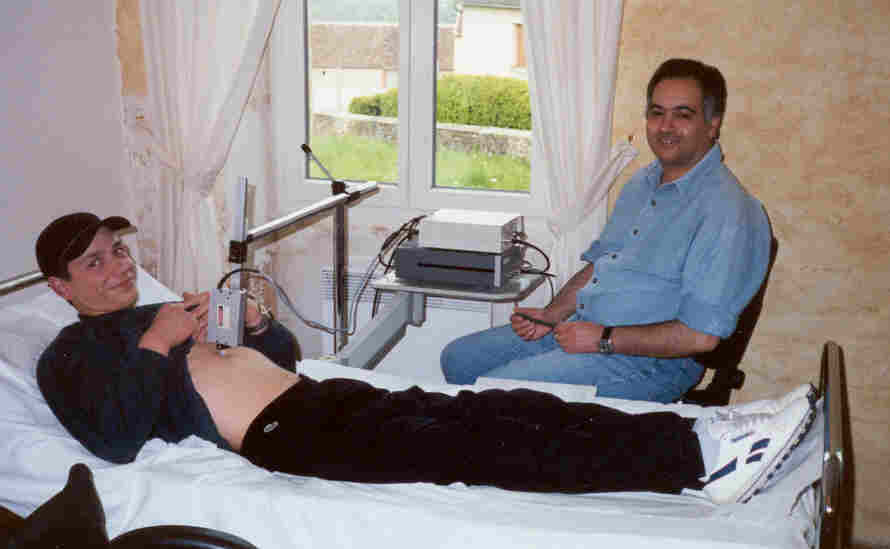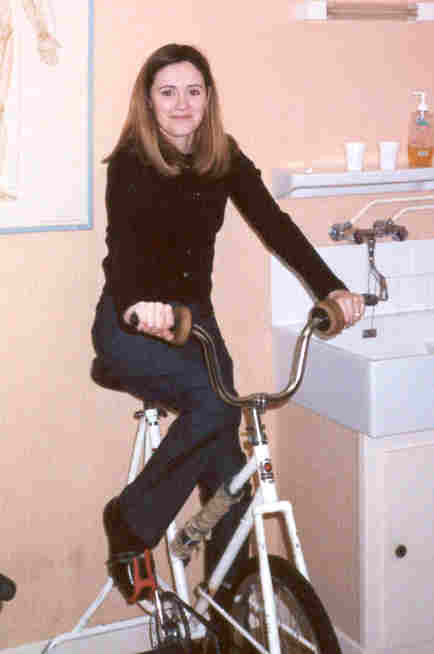
Laserpuncture is generating much attention in
France and other parts of Europe as an alternative medicine treatment for spinal cord injury (SCI) and related physical
disabilities. As the name implies, laserpuncture combines elements of acupuncture
and laser therapy, both of which have shown potential for restoring some
function after SCI.
 Albert
Bohbot, a charismatic health professional, developed laserpuncture.
Early in his career, he became interested in acupuncture’s potential
for treating a variety of disorders. With the assistance of scientists
at one of France’s leading engineering colleges, Bohbot developed a
sophisticated electronic instrument that substituted an infrared laser
light beam for acupuncture needles.
Albert
Bohbot, a charismatic health professional, developed laserpuncture.
Early in his career, he became interested in acupuncture’s potential
for treating a variety of disorders. With the assistance of scientists
at one of France’s leading engineering colleges, Bohbot developed a
sophisticated electronic instrument that substituted an infrared laser
light beam for acupuncture needles.
Treatment: Using
his device, Bohbot has treated more than 50 people with spinal cord
injury, most of whom were at least a year post-injury. He claims that
more than 60% have had substantial improvement. Although it was
difficult to get in-depth feedback due to language differences, the
patients I observed clearly supported Bohbot’s claims and often
routinely traveled great distances to obtain treatment.
In
each session, a laser beam is directed toward ten acupuncture points for
two minutes each. The selected points are a part of a large acupuncture
network covering the front and back of the patient’s torso. In
response to the stimulation, the patient will often feel sensations
below the injury level. Based on these sensations and any motor or
sensory improvement, ensuing sessions may focus on new acupuncture
points and use different energy frequencies.
 The
sessions are augmented with more traditional physical rehabilitation
therapy - at home or in the clinic – and are designed to enhanced
restored function (e.g., walking with leg braces using walkers or
parallel bars, riding a stationary bicycle, etc.).
The
sessions are augmented with more traditional physical rehabilitation
therapy - at home or in the clinic – and are designed to enhanced
restored function (e.g., walking with leg braces using walkers or
parallel bars, riding a stationary bicycle, etc.).
Observing
Bohbot’s patients doing this physical therapy was impressive. Many
consistently demonstrated regained physical abilities that seemed far
beyond what would be possible based on their medical records, a placebo
effect, or the physical therapy program by itself.
Because
benefits accrue over time with multiple sessions, it will be difficult
for most Americans with spinal cord injury to acquire this ongoing
treatment.
Bohbot
recognizes that there is a need to incorporate his in-depth experiences
and intuitive perspectives into training programs that will make the
treatment more universally available.
Acupuncture
Connection
Laserpuncture is based, in part, on Traditional
Chinese Medicine theories of acupuncture that believe that a life-force
energy permeates all living things through meridian channels. Through
needle insertion or the application of heat, pressure, massage, or other
energy sources at specific points on the skin, acupuncture promotes
energy flow.
Scientists believe acupuncture’s effects are
mediated through physiological mechanisms, such as the stimulation of
neural pathways and neurotransmitters. Considerable evidence suggests
that acupuncture has the ability to restore some function after SCI (see
Journal of Alternative and Complementary Medicine, Vol. 2, 1996, pp.
211 -248).
Laser
Therapy Connection
Many acupuncturists use lasers, which amplify
light by producing coherent light beams, instead of needles to
stimulate energy flow. Developed in the 1960’s, lasers often trigger images of
powerful, metal-cutting beams, in part, due to movies like Goldfinger in which a laser nearly dissects James Bond.
In
spite of this image, low-energy lasers are finding more therapeutic
applications (see Journal
Alternative and Complementary Medicine, Vol. 5, Number 2, 1999,
pp.177-188). They
represent a noninvasive, painless mechanism for biostimulation that does
not burn tissue. Scientists speculate that laser stimulation
improves cellular respiration and function and DNA and RNA repair.
Research suggests that laser therapy may restore
some function after spinal cord injury. For example, in one study, 15 of
31 subjects with spinal cord injury (at least three-years post-injury)
had some functional motor improvement after the spinal area surrounding
the injury site was treated with a laser for six hours a day for 21
days.
Laserpuncture:
Given that acupuncture and laser therapy show promise for treating SCI,
Bohbot’s positive results are not that surprising. Although the use of
lasers to stimulate acupuncture points is not new, Bohbot has developed
and refined this technology and directed it towards paralysis.
Bohbot’s
laser device specifically emits infrared energy - the part of the electromagnetic spectrum just beyond the limit of visible red light. The
power and frequency of this infrared energy can be adjusted to fit the
patient’s perceived therapeutic needs. Central to Bohbot’s therapy
is a network or matrix of more than 300 acupuncture points he claims to
have discovered that relate energy meridians to dermatome levels
(dermatome matches a specific spinal cord level with a given area of
skin feeling). He believes that stimulating energy flow through this network
can restore function.
Bohbot’s therapy seems to have restored
significant function in a number of people with supposed complete
clinical injuries. Because of such cases, Bohbot speculates it is
possible to restore some function even without intact neurons bridging
the spinal injury site. Substituting prevailing biomedical dogma with
innovative explanations involving quantum physics and energy medicine,
Bohbot believes that there are backup mechanisms to the spinal cord for
carrying messages from the brain to the body. He suggests that a signal
may be mediated through an electromagnetic energy impulse instead of
standard, biochemical conduction through intact neurons using
neurotransmitters.
As
an alternative, I suggested that improvement might be due to some
regeneration or the turning on of residual, but dormant, neurons that
have survived the injury. Scientists now believe that such dormant
neurons characterize many injuries clinically classified as
“complete” and only a few of these neurons to be turned on to regain
some function. Perhaps laserpuncture is a therapeutic switch that turns
them on.
Location:
Bohbot’s clinic is about 120 miles south of Paris in Sens Beaujeu, a
small village nestled in the bucolic Sancerre wine-producing region near
the Loire River. In springtime, vibrant yellow fields of blooming
rapeseed and vineyards of tumescent stalks emerging from winter’s
dormancy streak the verdant rolling countryside. Dotting the countryside
are picturesque, Lilliputian villages, seemingly untainted by the modern
age.
Bohbot’s clinic is located in a building that
once served as a presbytery for the neighboring 200-year old church.
Bohbot has personally restored this building, blending historical
architectural elements with the features of a modern, accessible clinic.
Because of the clinic’s emphasis on acupuncture,
an ancient, mind-body-and-spirit therapy, the church’s imposing spire
located at Sens Beaujeu’s heart triggered an image of ethereal
acupuncture, in which divine energy flowed through the needle-like spire
to the church and surrounding buildings (including Bohbot’s clinic),
and, in turn, out to the countryside through the meridian-like roads
converging at this point. What a place for a clinic!
Acknowledgement
& Resources: Thanks are given to Barbara Pichon and Edwige Nault
for translation. For further information, see
www.laserponcture.eu.
Adapted from Paraplegia News, September 2001
(For subscriptions, contact www.pn-magazine.com).